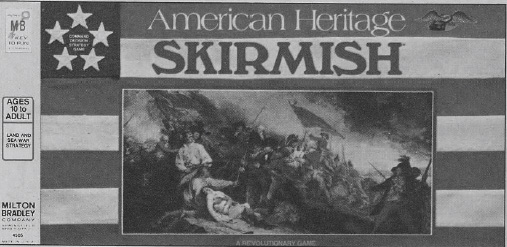Skirmish
A Revolutionary War GameMilton Bradley (1975)

Players 2
Period American Revolution
Scale Strategic/Abstract
Components
1 9½”x20” long box1 7½”x9½” cardboard tray box insert containing two smaller cardboard trays and a U-shaped cardboard divider
1 12”x9½” cardboard shelf box insert with color illustrations of American Heritage games
1 19½”x23½” mounted mapboard
18 page rulebook
49 red and blue plastic units
24 uncoated cards
1 32 page historical booklet (with color illustrations)
2 plastic dice cups
3 black six-sided movement dice (1x “0”; 3x“1”; 1x“2”; 1x“3”
1 red six-sided battle die
Plastic Unit Manifest
36 discs (18 red; 18 blue)4 red British army figures
2 blue American army figures
1 blue American Continental Army figure
4 warships (3 red; 1 blue)
2 troop carriers (1 red; 1 blue)
Comments
I like to describe the American Heritage series as “war themed” games since they are not really wargames in the grognard sense of the term. The games in the series adapted elements of history into family- strategy style rules. The main emphasis was on game, with history coming primarily through the historical booklets containing excerpts from American Heritage books.In 1975 Milton Bradley released Skirmish along with three of the original four American Heritage/Command Decision series games from the early 1960’s (Battle-Cry; Broadside; and Dogfight). From the American flag motif on their covers, it would seem that their rerelease was motivated by America’s bicentennial celebration. Skirmish made for a timely addition to the series as it dealt with the American Revolution. Skirmish, like Battle-Cry, took a large scale view of things. The Skirmish map depicts the east coast of the USA from southern Maine to northern Georgia and inland to western Pennsylvania. The map is divided into squares. The players start with assymetrical forces: the American player has 16 units scattered across the map while the British player starts with four armies composed of five units each. The British player has three warships off-shore to the American player’s single warship. Each player also has a troop carrier ship, which may be called for just once. When a troop carrier is summoned, the land war is temporarily put on hold while the player requesting reinforcements tries to move their troop carrier into a port before the opposing player intercepts it with a warship. The British have 2 units on their troop carrier while the Americans have 4.
There are two types of land combat in Skirmish: Skirmishes between units located at adjacent points; and Major Battles between units located on the same point. Skirmishes are resolved by card draw, and smaller forces may achieve some level of victory over larger armies. Major battles are resolved by die rolls which are weighted in favor of the larger force.
I am really looking forward to giving this game a try. The essence of the game is summed up by the hints on strategy printed on the rulebook back: “British Player: His armies have more power at the beginning of the game but lack mobility. He also has most sea control and can use the coastal ports to advantage in moving. His strategy is to try to engage in Major Battles early in the game. Divide and Conquer!”
“American Player: Has more mobility. Weak in early part of game, but usually gets stronger as game progresses. Small units have advantage in Skirmishes. His strategy: stay away from Battles — whittle away at British with Skirmishes. Build up armies to full strength before you go after Major Battles. Work toward getting Reinforcements.”
Collector’s Value
Skirmish appears fairly regularly on eBay, and good copies can be found for around $20, sometimes less. As with any game from a collectable series, beware of bidding wars! Boone lists low/high/ average prices of $12/$55/$24.98 at auction and $19/$75/$32.40 for sale.Games Reviewed
Back to Simulacrum Vol. 4 No. 2 Table of Contents
Back to Simulacrum List of Issues
Back to MagWeb Master Magazine List
© Copyright 2002 by Steambubble Graphics
This article appears in MagWeb (Magazine Web) on the Internet World Wide Web. Other military history articles and gaming articles are available at http://www.magweb.com